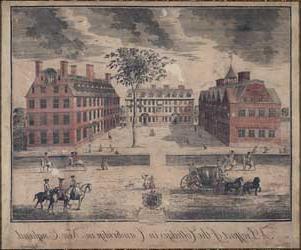收藏在线
A Prospect of the Colledges in Cambridge in New England
-
Choose an alternate description of this item written for these projects:
- MHS收集历史
- MHS 225周年纪念
- 主要描述
[ This description is from the project: 见证美国的过去 ]
The only known impression of the first state of William Burgis's view of Harvard College certainly ranks high among the Historical Society's treasures but was only accidentally discovered in the 1880s. Dr. 费奇·爱德华·奥利弗(1819-1892), 协会的内阁管理员, reported to the February 1881 monthly meeting that the 1743 view of Harvard, published by William Price and given to the Society in 1795, was mounted on a wooden panel which had become warped and cracked and required attention. "On lifting it from the panel another engraving embracing the same view revealed itself ... similar in character, but published at an earlier date." It was Oliver himself who connected this earlier print with Burgis's announcement for "A Prospect of the Colledges in Cambridge in New England, 铜雕,出现在 波士顿新闻信函 1726年7月26日.1
William Burgis had a short but active working career as an artist. 他的早年生活鲜为人知. He probably arrived in New York from London sometime in 1717. His first known work was a large panorama of New York, A South Prospect of the Flourishing City of New York (1717; published 1719-1720). 在铭文中, Burgis's name appears as the designer and publisher, and the engraver has been identified as John Harris, who is also believed to have engraved the view of Harvard. 哈里斯在伦敦工作, where he specialized in architectural and topographical views after a number of artists.2 During this early period of American printmaking, it was common practice to send drawings to Europe to be engraved and printed.
Burgis is believed to have been living in Boston in 1722. A small print of a view of Boston from that year might be his first work executed here. 这是波士顿的景色, 现在在埃塞克斯研究所, was taken from Noddles Island and depicts an artist drawing in the right hand corner. If this is indeed the work of Burgis, then the figure may be a self-portrait. Burgis is definitely the artist for the later panoramic view, A South East View of the Great Town of Boston in New England in America (1725), which was also engraved by John Harris.3
This 1726 view of Harvard gives an accurate picture of the college as it appeared in the early eighteenth century. 这三座建筑是, from left to right: Harvard Hall (built 1672-1682), Stoughton Hall (built 1698-1700) and Massachusetts Hall (1718-1720).4 All three buildings were constructed of brick, evident in the use of red wash for the hand coloring. Harvard Hall, the oldest of the three, replaced an original wood structure. The flag flying above the cupola on Harvard proclaims, "HC 1639," which is the date for the original building. The courtyard before the three buildings contains a lone elm tree and several men in academic gowns scurrying along.
街上, which is separated from the college by a plain fence, contains a great deal of genre details which enliven the view. 在左边, 例如, two horsemen trot past an elegant four-horse coach, 而在中心, above the dedication to Lieutenant Governor Dummer by Burgis, a 绅士 points out the buildings to a woman, 一只狗在旁边看着.
自从搬到波士顿, Burgis resided at the Crown Coffee House which was located at the head of Long Wharf. His landlord, Thomas Selby, was involved in the production and sale of some of Burgis's prints. When Selby died in 1727, he left his widow, Mehitable, a large fortune. The next year, she and Burgis were married. 然而, because the estate was disputed by other Selby heirs, Burgis and his wife spent much of their life together involved in litigation.5
在法庭记录中, Burgis listed his profession variously as a draftsman, 画家, 绅士, 和小旅店的老板, 但从来没有作为一个雕刻师. The only work which he inscribed as both designer and engraver is a mezzotint, To the Merchants of Boston this View of the Lighthouse (1729). 同年,伯吉斯画了一张地图, 新英格兰的波士顿平面图,由托马斯·约翰斯顿雕刻. According to Dunlap, Burgis left his wife in 1731 and returned to New York. 然而, 两幅描绘纽约风景的版画, 乔治堡和新荷兰教堂, date from 1729-1731 and 1731 respectively, indicating that Burgis may have been in New York before that date.6 1736年7月, his wife unsuccessfully filed for divorce claiming that "her Husband William Burgess having got what he could of her estate into his hands about five years since left her, and has never returned to the Province again."7 Nothing further is known of Burgis's life or his career as an artist after 1731.
1. Proceedings of the 马萨诸塞州历史学会. (波士顿,1880-1881):第18页. 318-320.
2. 格洛丽亚·吉尔达Deák. 描绘美国,1497-1899. 2波动率. 普林斯顿,1988,1:pp. 44-45; Hamilton Vaughn Bail. Views of Harvard: A Pictorial Record to 1860. 剑桥,麻., 1949, p. 21; 《og体育官网》. 莱斯利·斯蒂芬斯和西德尼·李编. 22日波动率. 1885-1901年,伦敦,1959-1960年.
3. 理查德·B. 霍尔曼. “威廉Burgis." Boston Prints and Printmakers, 1670-1775. 出版物 of the Colonial Society of Massachusetts. 46, 1973, pp. 58, 64, 65, 78.
4. 格洛丽亚·吉尔达Deák. 描绘美国,1497-1899. 2波动率. 普林斯顿大学,1988,1:p. 49.
5. 威廉•邓拉普. A History of the Rise and Progress of The Arts of Design in the United States. 3日波动率. 波士顿,1918,3:286; 约翰一. 埃德蒙兹. "The Burgis Views of New York and Boston." 波士顿学会学报. 1915, pp. 46-47.
6. 理查德·B. 霍尔曼. “威廉Burgis." Boston Prints and Printmakers, 1670-1775. 出版物 of the Colonial Society of Massachusetts. 46, 1973, pp. 58, 72-73, 79-80; 威廉•邓拉普. A History of the Rise and Progress of The Arts of Design in the United States. 3日波动率. 波士顿,1918,3:286.
7. 约翰一. 埃德蒙兹. "The Burgis Views of New York and Boston." 波士顿学会学报. 1915, p. 46.

